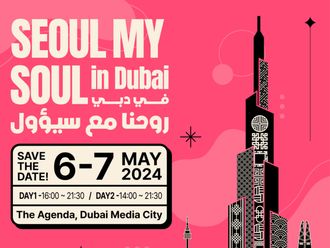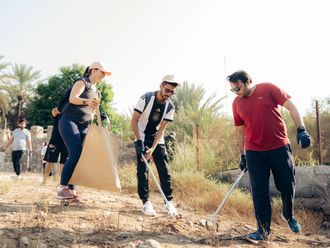Have the UAE's zoos kept up with the evolution of zoos around the world? Friday talks to the management of the Dubai and Al Ain zoos
Devdas feeding the cub Mina. ©Gulf News |
The evolution, the IUCN says, is primarily reflected in two areas: the exhibitry used, which have gone from cages to dioramas to the current standard of immersion exhibits; and the zoo's primary concerns, which began with species' propagation and husbandry to cooperative species management and, now, holistic conservation.
The changing trend has been brought about by unlikely twin forces: destruction and awareness. As the world loses more and more natural habitats and the species that live in them, the realisation has dawned that zoos are in a prime position to provide solutions.
The only way to restore the natural balance is to first maintain the species lost in the wild, then educate the public about the role played by these ecosystems and animals and, finally, to reintroduce the animals to safe, rehabilitated areas.
Major zoos in the U.S, Europe, Asia and Australia do all of these things by prioritising education, conservation, recreation value and, in the case of privately-owned zoos, commercialisation. They not only manage endangered species and other animal populations, but educate the public, conduct valuable research and partner with conservation projects around the world.
But have the UAE's zoos evolved to keep up with these changing priorities? In the three priority areas – both zoos are government-owned – the Dubai and Al Ain zoos have had varying degrees of success.
Friday met with Ahmed Mohammed Abdulkarim, director of Public Parks and Horticulture for Dubai Municipality, and Dr. Nael Abu-Zeid, technical director of Al Ain Zoological Park and Aquarium.
"Ours is not a commercial zoo," says Abdulkarim. "It is an educational-cum-research organisation. Dubai Zoo is in the process of evolution – as you know, Rome was not built in a year or two."
"The zoos of Europe and the Americas or Australia are also in evolution," he says, "and they have reached their present, modern condition only after 1980 or so, after an existence of no less than half a century. We hope to overcome all the hurdles we are facing at the moment once Dubai builds a new zoo."
Al Ain Zoo, the largest in the country, has started improving in the last few years after prolonged isolation. It is only recently that new immersion exhibits along the lines of those in the West have been built to replace the old cages, and new plans are under way for more enclosures that will be good for both animals and for visitors.
"The perception of Al Ain Zoo has changed greatly in international circles also," says Dr. Nael.
"For the first time, we are taking part in international seminars and conferences and sharing information about the animals that we have, the work that we are doing, and paving the way for future specimen exchanges and research programmes."
Education
Although both zoos are popular with schools and students, their signage and display information is limited to basic and relatively hard-to-find labelling in the case of Al Ain Zoo and slightly better offerings at Dubai Zoo.
In Dubai, they are working on more and bilingual name boards. For their part, Al Ain Zoo authorities say they are just starting to realise one of their goals of having trained interpreters and guides available to escort visitors through the zoo and inform them about the different animals and their ecosystems.
The zoo has also started meeting the city's educational district officials about collaborative projects.
Constraints
Space is a major constraint for Dubai Zoo, which occupies only two hectares. Despite the limited space, the zoo is doing what it can by not procuring new animals and exchanging those born there.
"We are sometimes forced to accept confiscated animals from different government bodies and members of the public," Abdulkarim says.
Dubai Zoo also has a release programme to reduce pressures on their space, and also rehabilitates and stocks UAE reserves.
At Al Ain Zoo, space is not an issue. In recent weeks, the zoo's area was increased to 770 hectares, to include the future breeding centre, safari park and game reserve. Overcrowding, however, is fast becoming a concern – the zoo currently has 2,150 mammals, and
most of them have to make do with habitats are far removed from their natural ones.
"I was also greatly surprised by the animals that we had when I first came here," says Dr. Nael. "But at the same time, we have to accommodate the ones we have. That's why we're starting to establish global compacts so we can trade some animals."
Plans
Although a new Dubai Zoo has been planned for several years, little has materialised. "We do not like to make mistakes in building something today and cursing our decision a decade later," says Abdulkarim.
"The zoo is taking a lot of time because it is a complicated project. We are focusing on three to four main areas, including how to have a high standard of living for the animals, taking into consideration the natural environment and weather here. Each species will have its own habitat."
Other priorities are to develop a zoo with sustainable high standards and one so multi-faceted in design and features that it will encourage return visitors. The new Dubai Zoo, for example, will include a night safari, along the lines of the Singapore Zoo, and a safari park.
In Al Ain Zoo, the 'Africa Close Up' programme is one of the more optimistic plans. Parts of the project, which involve better habitats, larger enclosures and prime viewing areas for visitors, have already been built for the gorilla and other animals.
In some areas, habitat restoration has begun. "We are building ourselves brick by brick instead of one wall at a time," says Dr. Nael on the future of the zoo. "We are like an infant now, we are crawling. Soon we will be running, but it will take some time. We have begun to change the minds of the policy-makers."
Changing philosophy
"In the past, the philosophy was to put an animal in a cage," says Abdulkarim. "In the last 10 years, that philosophy has changed to be more friendly to the animals and to the environment."
Despite the fact that almost all the animals in Dubai Zoo are in cages, the director says progress has been made. "We have airconditioning systems, good maintenance and cleaning systems; we do our best to try and protect the animals," he says.
At Al Ain Zoo, staffers have long been concerned with the welfare of the animals, Dr. Nael says, primarily because the Rulers place so much emphasis on the same. But a large chunk of the public still comes to the zoo to be e












